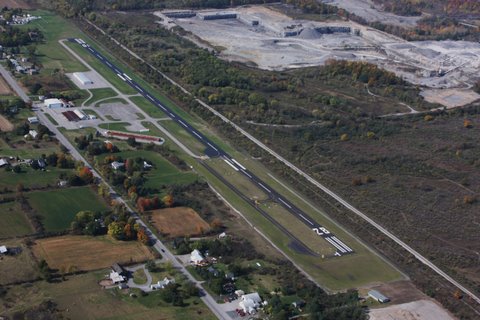
Le Roy Airport (5G0) from RWY 28 - When landing on runway 28 be mindful of houses on base leg and the tree on the right on final approach.
When I started my flight training all of it was done in a Cessna 172. Probably 95% of my total time as a pilot was in a 172, but the times they are a changing. These days I am spending time in a Cherokee to build PIC time in a low wing aircraft. And now that the Arrow is back from the shop I will get back into flying that plane to earn my complex endorsement.
If you have flown a Cessna and tried a short field landing, you know that you can almost fly them in like a parachute at 55 kts (or less) and get away with it and even get a bit cocky about it acting like a bush pilot without even hitting dirt. However, a Cherokee or an Arrow is NOT the same animal and there are probably a few people who flatten a few like pancakes by finding out the hard way that they can sink quickly making the air between you and the runway seems to disappear.
These low wings like speed and if you are at a field that is challenging and you have a few with obstructions at the end of the runways, you might find yourself figuring out in flight (like I did) how to land with speed on a glide path that will not get you hung up like a kite in one of those trees. Such was the case at the airport in Le Roy (5G0) yesterday.
Le Roy Airport was once 2,600 ft and in the past year was expanded to 3,855 ft. My experience with this field always involved having my instructor with me during my training days using the good old 172. The field was a great place to learn short field take offs and landings in the 172, and it seemed much smaller because it’s in a tight spot between a road and a quarry with trees along the length of the strip.
A few months ago I went to Le Roy with my instructor and the Cherokee to grab a bite to eat at my brother and his girlfriend Lisa’s restaurant, the Gunsmoke Country Grill two miles east of the field. On that day I don’t recall the winds being an issue. In fact I can’t remember much of anything about the flight except it was my first time there with a Cherokee and winds were down the runway I believe. Anyway, yesterday the winds were coming out of 340 at 10kts with gusts up to 14kts, which gave me a crosswind component of 10kts. This number was fine for the aircraft but for me it proved challenging.
Here is some information I found on line about Piper’s and crosswinds:
In the air, a Piper nose wheel will move with the rudder. On the ground it moves with the rudder. In a crosswind landing it moves with the rudder. This means that a cross-control landing slip in a Piper will have the nose wheel cocked away from the low wing and into the wind. Severe landing loads are put on the nose wheel if it is allowed to touch down in this cocked position. It may ever result in a ground loop. The nose wheel of a Piper should never be allowed to touch the runway during landing without having been first aligned with the direction of motion.
The engineering geometry of the Piper nose wheel is different from Cessna. The nose steering is directly linked to the rudder pedals. Move the nose wheel; move the rudder. Crosswind landings in Pipers require a slightly different technique than with Cessnas. Because of the nose wheel geometry any cross control which will hold the nose straight with the runway during a crosswind landing will have the nose wheel turned. For this reason it is important that the nose wheel not be permitted to touch the runway until it has been straightened. Otherwise, an abrupt turn or ground loop may occur.
During the crosswind landing the rudder effectiveness of the Piper is less than that available to the Cessna. The rudder area is smaller. Additional speed may be required to increase rudder effectiveness. As crosswind velocity increases and approaches the 90-degree angle, the flap settings should be decreased appropriate to pilot ability.
My problem was that I was flying a Piper and aviating like I had a Cessna. On my final approach I was cross controlled. I turned my aileron into the wind (right) and used left rudder to balance between gusts and to try to keep it center. I know this is NOT what all Piper pilots would do, but I need to tell the tale. Anyway while I was doing this I was getting lower and slower, and started to dip to 80 MPH (yes I did have full flaps too) and I also had a tree to the right of me on the approach. All of these observations caused me to say…hey…let’s try this again! So I did a go around and cleaned up the plane just fine.
Please note that I am a conservative pilot by nature. I don’t subscribe to “I got to nail this” landing attitude. I just don’t want to break me or a nice plane (I would feel really bad about the plane).
So what I didn’t fully appreciate was that additional speed may be required to increase rudder effectiveness in the Cherokee and the more I slowed down the worse I was making things for me on a few fronts. I sank more and was running out of rudder.
I also thought about but ignored that as the crosswind velocity increases and approachs the 90-degree angle, the flap settings should be decreased appropriate to pilot ability. Why? Because I was just coming to terms with the part about pilot ability since I was not trained much in this plane except for the purpose of flying an Arrow (boy I want to fly that Arrow right now) and nothing more, I didn’t know exactly my full ability. The reality is that you have to fly to know your ability and sometimes you do that as the sole occupant as PIC.
So with my go-a-round still in my head I made a second attempt at landing. This time my final was slightly on the windward side of the approach. I figured this way, if I was pushed to the left, I had more time to correct as I was pushed to the centerline. I also increased my speed by 5 to 10 MPH and increased my altitude making the tree less of a factor since I would have to fly over it more but be much higher from it.
Yeah…this is why they say A Pilot is Always Learning.
In the end I got it in and got it down on the first 3rd of the runway. I kept the ailerons into the wind and used rudder to straight myself out since I was still left of the centerline. I did kind of drop it in…wish there were better words because I didn’t DROP it…like BAM…but it felt like the mains and nose can down together a few inches (no not feet) from the runway.
In the end I met my brother and his son at the field and told them that today would not be a day that we take to the skies. I didn’t want to put anyone in a situation. Instead I explained all of the gauges and controls to my brother and my nephew who sat in the pilot seat, a nice ground school of sorts and they enjoyed that just fine.
Leaving was a non-event, crosswind take-offs are not an issue at all for me, and in Penn Yan the winds were straight down runway 36 so that landing was fine. Naturally after sunset the wind was gone and a perfect night settled in like a warm blanket. Very nice!


4 Responses
Pilots learn best when the experience is intense. You will now be a more capable pilot in challenging winds.
The Cherokee nose wheel should not be an issue in cross winds with proper control technique.
Landing flat (upwind and nose wheel touch at the same time) can result in a swerve when side slipping to landings in Cherokees.
The ailerons keep you over the center line, the rudder keeps the nose pointed down the runway when side slipping to cross wind landings.
Once the up-wind main is on the ground, the ailerons are used to keep it there. As the up-wind main touches, the rudder keeps the nose pointed down the runway. If the nose is pointed down the runway, there is no swerve.
Welcome to the positive reinforcement factor flying Cherokees in cross winds.
Why hasn’t your instructor made you fly in challenging cross winds?
My instructor is too busy posting on my blog at night to go over crosswind take offs and landings, or was it Civil Air Patrol he is too busy with? 😉
You forgot primary students at PEO.
🙂
Ah…yeah…trying to avoid that one.